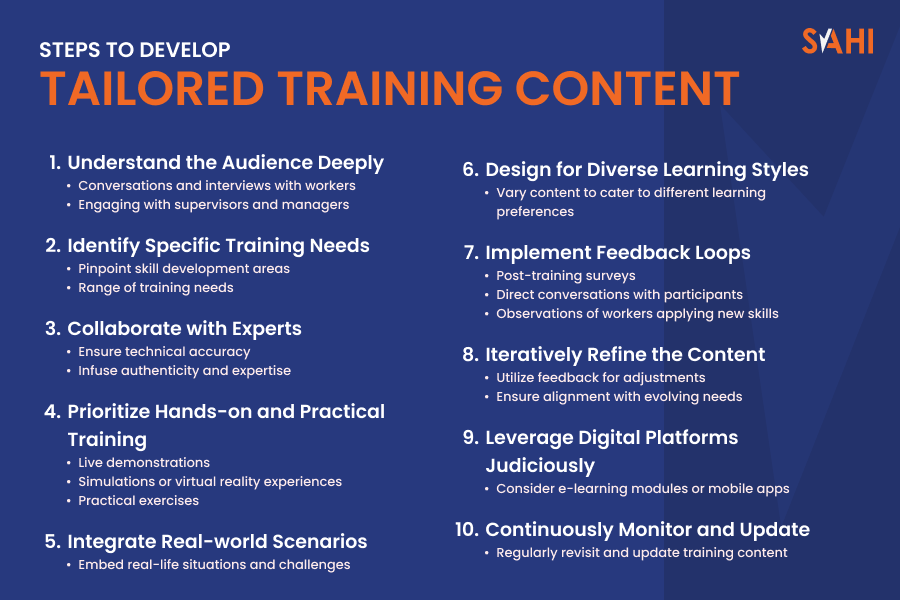In today’s rapidly evolving business landscape, ensuring that employees are equipped with the right set of skills is imperative for organisational success. However, while there are myriad employee training programs available in the market, not all are tailor-made for every segment of the workforce.
This holds especially true for blue-collar workers, who form the backbone of many industries. Let’s see how in this guide.
Why Does the General Training Content Fall Short?
A significant portion of the readily available training content tends to be generic. While they may cater to a broad audience, they often fail to address the specific needs, challenges, and aspirations of blue-collar workers.
The generic nature of these programs can result in a lack of engagement, limited retention of information, and a reduced impact on skill development.
Moreover, the content’s presentation, language, and format might not always resonate with blue-collar workers. It’s essential to understand that the challenges faced by a manager in a corporate office and a technician on a factory floor are vastly different.
A one-size-fits-all approach to training can leave gaps in the learning process, making it less effective.
The Growing Need for Custom Content for Blue-Collar Workers
As industries evolve, so do the skills required by blue-collar workers. Whether it’s the introduction of new machinery, adoption of digital tools, or updated safety protocols, blue-collar workers are constantly navigating a shifting work environment.
This is where custom content steps in. Tailoring content to address the specific needs of blue-collar workers ensures that the training is not only relevant but also engaging.
By focusing on real-world scenarios, challenges, and solutions that blue-collar workers encounter daily, custom content bridges the gap left by generic training modules.
Customised blue-collar training programs not only foster a deeper understanding of the subject matter but also ensure that the training is relatable. When learners can see the direct application and relevance of what they are being taught, it naturally enhances their engagement and participation.
This heightened engagement leads to better retention of knowledge. Thus it guarantees that the training isn’t just another box-ticking exercise but a genuine boost to their work productivity and skill set.
The Current Landscape of Training Content: A Deep Dive into the Generic and the Specific
Training and development have emerged as quintessential elements in today’s corporate world. With technological advancements and the dynamics of a constantly changing work environment, it’s paramount for organisations to invest in employee development.
As a result, it will help them maintain their competitive edge. But, is the current landscape of training content truly serving the needs of all segments of the workforce, especially blue-collar workers?
A Glimpse into the Generic Training Materials
A vast majority of training development materials available today are designed with a generic audience in mind. These materials often encompass a wide range of topics, from soft skills like leadership and communication to more technical areas such as software use or safety protocols.
These resources often come packaged as ready-to-use modules, boasting versatility across different industries and roles.
Leading digital content providers play a pivotal role in disseminating these materials. The allure of these generic resources lies in their broad applicability and the perceived ease of implementation.
But why design a new module when there’s already a pre-made one available?
The Shortcomings of Generic Training for Blue-Collar Workers
While these generic training modules may offer a foundational understanding of various topics, they falter when it comes to catering to the unique needs of blue-collar workers. Here’s why:
- Lack of Relevance: Blue-collar jobs, by their very nature, are often more hands-on and task-specific. A generic module on machinery safety might touch upon general principles but may miss out on the intricacies of a specific machine used by a particular group of workers.
- Differing Learning Styles: Blue-collar workers often benefit more from practical demonstrations and real-world examples. Generic content, laden with jargons and theoretical explanations, might not resonate with them, leading to reduced work productivity and inefficiencies.
- Gap in Skill Application: The skill development process for blue-collar workers is heavily reliant on immediate application. Generic content might provide a broad overview but can fail to dive deep into the nuances, leaving workers underprepared for their specific roles.
- Mismatched Engagement: A module designed for a tech-savvy audience, emphasising teaching with digital technology, might disengage a blue-collar worker who prefers hands-on training or face-to-face interactions.
In the world of training solutions, one size certainly doesn’t fit all. Blue-collar workers require training materials that speak to their experiences, challenges, and daily tasks.
While generic content can provide a baseline, it often falls short in delivering comprehensive, relevant, and engaging training tailored to the needs of blue-collar workers.
In essence, the current landscape of training content, though vast and diverse, requires a more focused approach when addressing the unique requirements of blue-collar workers. It’s a clarion call for organisations to prioritise custom content and blue-collar training programs that genuinely cater to the heartbeat of their operations.
The Need for Custom Content Exploration: Addressing the Unique Learning Dynamics of Blue-Collar Workers
In the vast ecosystem of employee training programs, a nuanced understanding of diverse employee segments is paramount. Among these segments, blue-collar workers present a distinct set of learning needs and challenges that generic training content often overlooks.
Exploring the necessity for custom content becomes not just a preference but an imperative to truly harness the potential of this vital workforce.
Unique Learning Needs of Blue-Collar Workers
- Hands-on Learning: Unlike white-collar roles, where theoretical knowledge might suffice for various tasks, blue-collar jobs demand practical know-how. These workers often learn best through tactile experiences, demonstrations, and real-world simulations. Training solutions that cater to this hands-on approach can exponentially boost comprehension and application.
- Job-specific Knowledge: While a management professional might need a broad understanding of various business domains, a blue-collar worker requires deep insights into their specific role. Whether it’s operating a particular machine or following a specialised safety protocol, the skill development process for them is much more concentrated.
- Cultural and Linguistic Considerations: Blue-collar workers might come from diverse cultural and linguistic backgrounds. Custom content can be tailored to respect these diversities, ensuring that language or cultural nuances don’t become barriers to learning.
Challenges Faced by Blue-Collar Workers in Standard Training Programs
- Lack of Relevance: As mentioned, generic training modules might touch upon various topics, but they often miss the mark in terms of direct relevance to a blue-collar worker’s daily tasks.
- Over-reliance on Digital Tools: While the world is swiftly moving towards teaching with digital technology, assuming that every blue-collar worker is tech-savvy can be a misstep. Not every worker might be comfortable with high-tech digital interfaces, which can lead to disengagement.
- Pace and Flexibility: Blue-collar workers might require a different pace of learning, with some needing more time on certain topics and less on others. Generic content seldom offers this flexibility.
Emphasising the Importance of Tailored Content
Given these unique needs and challenges, it becomes evident that a custom content approach for blue-collar training programs is not just beneficial but essential. Tailored content:
- Aligns with the worker’s daily experiences, making learning more intuitive and applicable.
- Offers the flexibility to adjust to different learning paces, ensuring no worker is left behind.
- Respects and addresses cultural and linguistic differences, creating an inclusive learning environment.
- Prioritises hands-on learning and practical demonstrations, resonating with the worker’s preference for tactile learning experiences.
Benefits of Custom Content for Blue-Collar Training
In the competitive landscape of industrial and manufacturing sectors, blue-collar workers are the driving force behind the tangible products and services that propel the economy forward. Given their pivotal role, it’s essential to ensure they have access to the best training resources.
Enter custom content, a beacon in the training development arena. Here’s a deep dive into the myriad benefits that tailored content offers to blue-collar training programs.
Enhanced Engagement with Relevant Content
Generic content can sometimes feel detached from a worker’s day-to-day experiences. In contrast, custom content, specifically designed for blue-collar tasks, immediately captures attention. Whether it’s a module about a machine they operate daily or safety protocols for their specific role, the relevance of custom content ensures that workers remain engaged, seeing the direct connection between what they learn and what they do.
Improved Retention through Hands-on Learning Experiences
One of the cornerstones of effective skill development is retention. Custom content can be structured to prioritise hands-on learning, resonating with the tactile nature of blue-collar jobs. When workers can touch, feel, and practise what they’re learning, it cements knowledge far more effectively than mere theoretical instruction.
Accelerated Skill Application with Real-world Scenarios
Custom content for blue-collar training programs can incorporate real-world scenarios, problems, and solutions that workers face daily. This practical approach means that post-training, workers can quickly apply their newly acquired skills on the job. The gap between learning and application narrows, leading to immediate performance improvements and enhanced work productivity.
Catering to Diverse Learning Styles and Paces
Blue-collar workers come from diverse backgrounds and have varied learning styles. Custom content allows organisations to offer modular and flexible training solutions, adapting to individual needs. Whether it’s visual aids for those who learn by seeing, practical demos for tactile learners, or detailed explanations for those who prefer in-depth understanding—custom content can cater to all.
Boosting Confidence and Morale
When training feels relevant and achievable, it boosts workers’ confidence. They don’t just gain new skills; they also feel valued and understood by their organisation. Recognizing the unique challenges and needs of blue-collar workers and addressing them through tailored content can lead to increased morale, job satisfaction, and loyalty.
Cost-effective Training with Tangible Results
While creating custom content might seem like a hefty upfront investment, its long-term benefits make it cost-effective. Better engagement and retention mean fewer repeated training sessions, reduced errors on the job, and a faster return on investment. Essentially, organisations get more bang for their buck with custom content that truly resonates with their blue-collar workforce.

Steps to Develop Tailored Training Content
The crux of any successful employee training program lies in its relevance to the target audience. When it comes to blue-collar workers, this relevance takes on even greater importance due to the specialised nature of their tasks.
So, how does one go about developing tailored training content that not only educates but also resonates? Let’s embark on this step-by-step journey.
Understand the Audience Deeply
Before embarking on content creation, invest time in understanding the blue-collar workforce. This includes:
- Conversations and interviews with workers to gauge their daily tasks, challenges, and existing knowledge levels.
- Engaging with supervisors and managers for insights into performance gaps and areas of improvement.
Identify Specific Training Needs
With a deep understanding of the audience, pinpoint the specific skill development areas required. This could range from operating a new piece of machinery, adhering to updated safety protocols, or mastering a particular technique.
Collaborate with Experts
Ensure that the content you develop is technically accurate and up-to-date. Collaborate with on-site experts, technicians, or experienced blue-collar workers to infuse authenticity and expertise into your training modules.
Prioritise Hands-on and Practical Training
Given the nature of blue-collar jobs, emphasise hands-on training. This could include:
- Live demonstrations.
- Simulations or virtual reality experiences, if teaching with digital technology is feasible and beneficial.
- Practical exercises where workers can practise newly learned skills.
Integrate Real-world Scenarios
Embed real-life situations and challenges into the training content. This not only makes the training relatable but also prepares workers for actual on-job situations, enhancing their problem-solving abilities.
Design for Diverse Learning Styles
Remember, not every blue-collar worker learns the same way. Some might prefer visual aids, while others benefit from detailed explanations or tactile experiences. Ensure your content is varied and caters to these different learning preferences.
Implement Feedback Loops
Once the training is rolled out, gather feedback. This can be done through:
- Post-training surveys.
- Direct conversations with participants.
- Observations of workers applying their new skills on the job.
Iteratively Refine the Content
Utilise the feedback to make necessary adjustments to the training content. This ensures that the training solutions are always aligned with the evolving needs of the workforce and the industry at large.
Leverage Digital Platforms judiciously
If certain segments of the blue-collar workforce are comfortable with technology, consider leveraging digital content providers. Platforms like e-learning modules or mobile apps can offer flexibility in learning, allowing workers to revisit content as needed.
Continuously Monitor and Update
The world of blue-collar work, like all industries, evolves. Regularly revisit and update your training content to ensure it remains relevant, accurate, and effective.
The Power of Custom Content in Blue-Collar Training
As we navigate the complexities and intricacies of employee training programs, one fact remains clear: the need for relevance, accuracy, and adaptability in training content. For blue-collar workers, this isn’t just a nice-to-have but an absolute necessity.
The landscape of generic training materials often falls short when it comes to addressing the unique needs of blue-collar jobs. These roles, grounded in hands-on tasks and specialised operations, require training that’s not just informative but also directly applicable.
This is where the potential of custom content shines brightest.
Crafting tailored content for blue-collar training programs means diving deep into the day-to-day experiences of these workers. It’s about understanding their challenges, their learning preferences, and the ever-evolving nature of their roles.
The benefits of such a bespoke approach are manifold and doesn’t end at better training sessions. It extends to real-world outcomes – a more competent workforce, reduced training costs, fewer on-job errors, and a boost in overall morale and confidence among workers.
In a world where skill enhancement is the key to growth, the right training approach can make all the difference. For blue-collar workers, this right approach is undeniably rooted in custom content. It’s more than just a training tool.
It’s a strategic investment in the future, ensuring that every blue-collar worker is equipped, empowered, and engaged in their role.
Invest in the Future: A Call to Action for L&D Heads
The ever-evolving world of industrial and hands-on sectors demands training that’s not just robust, but also deeply relevant. As stewards of employee development, the responsibility of crafting effective training programs rests heavily on your shoulders.
But in this expansive sea of generic training solutions, how do you ensure your blue-collar workforce receives the best?
The answer lies in custom content.
So, we urge you to take a decisive step. Allocate the necessary resources, collaborate with experts, gather feedback, and embark on the journey of creating training content that truly resonates with your blue-collar workforce.
As a platform with 14 years of industry experience, SAHI can streamline this process for you. You can build the relevant skills and knowledge with custom content, ideal for digital or classroom learning, trainer guides, and micro-learning.
The rewards, both tangible and intangible, will undoubtedly be worth the effort.


